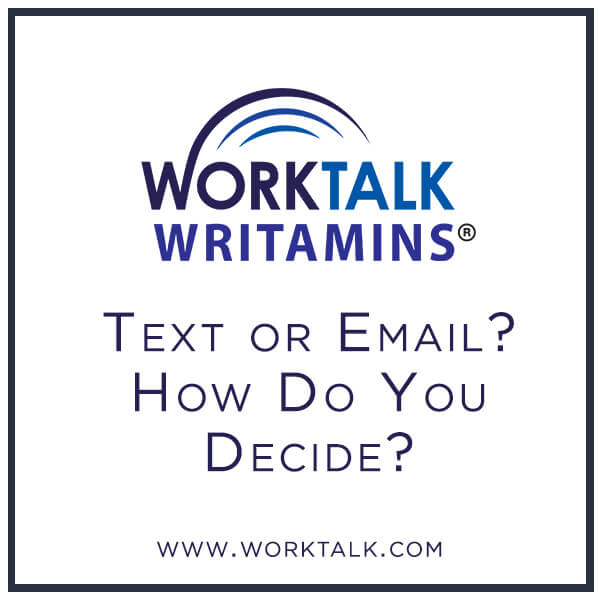ETA?
Can you talk?
5 minutes late
These and other pithy textisms ply the airwaves as people seek ever shorter ways of communicating with each other. If you are simply saying, “Running late” or “Confirming 1 pm lunch at Pats” and you need an immediate reply, texting is quicker and arguably more effective than email. If, however, you have a more substantive, less time-bound message, email is still the safer option.
Clients often ask us for guidelines about when to text and when to email. Texting practices vary widely among organizations, with some relying heavily on text messages while others hew to the email standard. Rather than prescribe a set of rules, we will set out factors to consider when deciding which medium to use.
Need for Immediate Response
If you have a short message and need an immediate response, texting is great. But remember that the text interrupts a person who may be in the middle of doing something else. Make sure your interruption is worthwhile.
Closeness of Relationship
Don’t text strangers. Texting is a more informal, personal form of communication; be sure your relationship with your reader supports this casual connection.
Reader’s Preference
I know people who whole voicemail message is, “Text me.” They don’t want phone messages and they barely tolerate emails. For these people, texting is the obvious choice.
According to Larry Alton in Forbes, Millennials text more than the over-40 crowd. Some savvy middle-aged folks are hip to texting but in general, the older the person, the less likely he or she is to be constantly attuned to texts. Emails and phone calls may get your message across better.
Follow your reader’s lead. When in doubt, make a phone call and ask for permission to switch to text before doing so.
Type of Message
Bad news does not belong in a text. A lost sale, a lost job, a project setback — all should be communicated on the phone or in person if possible. Email is a distant second when it comes to negativity.
Brief, actionable messages work well in texts. However, anything requiring more than a couple of sentences of explanation should go in an email.
Slack: A Game Changer for Business Communication
If you want to minimize both texting and emailing, consider using Slack for internal communications An instant messaging app, it eliminates the need for innumerable other communications and enables companies to work more effectively.
Points to Remember in Business Texts
Minimize acronyms, IMHO. Many people are not up to date with the latest acronyms. Don’t alienate your reader by using unfamiliar acronyms. Stick with LOL, BTW, and a few other common terms. Otherwise, use words.
Minimize emojis. I know they’re cute and might add a lighter tone to your message, but in business communications, emojis are rarely appropriate.
Don’t communicate the same message by email, text, and phone. Doing this makes people feel clobbered. Choose one medium and wait patiently for a response. If you have a sent a long, important email or voicemail and need an immediate reply, you can text, “Check your email/VM.” But give the person a chance to respond before you do.
Texting is a useful tool but email remains the most universally accepted form of business communication. If you need a person’s attention right away and your message is brief, go for the text. But to add context and explanation, choose email. And, if you’re really daring and want to include interaction and nuance, take a chance and make a phone call. You could even (gasp) meet in person.
Resources
Five Rules for Texting Anyone You Do Business With
The Rules of Business Texting
How Slack is Reinventing Internal Communication

©2018 Elizabeth Danziger All rights reserved
BOOK YOUR FREE CONSULTATION NOW Communication woes drag down productivity and morale. Book your free 30-minute “communications audit” consultation with Elizabeth Danziger. She will listen to your situation and suggest ways to improve communication in your organization right away. Contact her at lizd@worktalk.com or 310.396.8303.
~~~~~~~~~~~~~~~~~~~~~~~~~~~~~~~~~~~~~~~~~~~~~~~~~~~~~~~~~~~~~
Overcome the costs of poor communication today. Contact Elizabeth Danziger at lizd@worktalk.com or Emma Fialkoff at upworktalk@gmail.com to learn how you can achieve better business through better writing.
